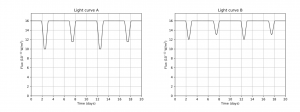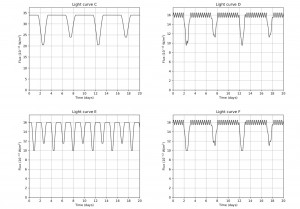2020年GeCAA理论第4题-光变曲线
The light curve A shown below, shows a fictional edge-on eclipsing binary system containing stars X (radius $$r_{X}$$ , luminosity $$L_{X}$$ ) and Y (radius $$r_{Y}$$ , Luminosity $$L_{Y}$$ ) . Assume that star X is brighter, but star Y is hotter.
(a) (1 point) Which of the two stars is likely to be on the main sequence? (Write “X”or “Y”)
(b) Based on light curve A, estimate:
(I) (2 points) $$\frac{r_{X} }{r_{Y}} $$, the ratio of the radii of the two stars.
(II) (2 points)$$\frac{L_{X} }{L_{Y}} $$, the ratio of the Luminosity of the two stars.
(c) (15 points) For light curves B to F, in each case only one parameter of the binary system has been changed from the case in light curve A. For each case, choose the description from the following list that best corresponds to the change (Write the appropriate roman numeral in the answer sheet).
(i) Star X increased in size.
(ii) Star X increased in luminosity.
(iii) Star X decreased in size.
(iv) Star X decreased in luminosity.
(v) Star Y increased in size.
(vi) Star Y increased in luminosity.
(vii) Star Y decreased in size.
(viii) Star Y decreased in luminosity.
(ix) Star X is a variable star.
(x) Star Y is a variable star.
(xi) The inclination of the system relative to the Earth has changed.
(xii) The distance of the system from the Earth has decreased.
(xiii) The distance of the system from the Earth has increased.
(xiv) The orbital period of the system increased.
(xv) The orbital period of the system decreased.

